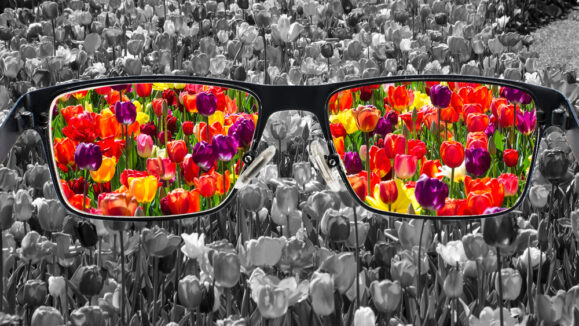With the global myopia epidemic showing no sign of slowing up any time soon, innovative and progressive treatments could prove crucial in tackling the growing problem. Among such promising solutions are myopia control-specific spectacles. Being relatively non-invasive and devoid of complications, these specs prove very popular among myopia sufferers — especially children, who are unfortunately most vulnerable to this condition.
Myopia control spectacles are eyeglasses designed to slow down or halt the progression of myopia in children and adolescents. These glasses feature specialized lenses that work by altering the way light enters the eye, reducing the amount of strain placed on the eye’s focusing mechanism.
The lenses used in myopia control spectacles can take several forms, including multifocal lenses, extended depth of focus lenses (EDOF), and peripheral defocus lenses.
Where in the world?
Myopia control glasses are gaining popularity worldwide, and they are particularly popular in East Asian countries, such as China, Taiwan, Hong Kong, and Japan — where myopia rates are among the highest in the world.
In East Asia, it is estimated that as many as 80% of children may develop myopia by the time they reach adulthood. This has led to extensive research and development of myopia control options in these countries, including myopia control spectacles.1
One reason for the popularity of myopia control glasses in East Asia is the recognition of the potential long-term negative effects of myopia. Studies have linked high myopia with a range of ocular disorders, such as glaucoma, retinal detachment, or even blindness in later life.2 With the rise of myopia in East Asian countries, the emphasis is on early identification and treatment.
Will the West follow?
In countries like Australia, Canada, the United Kingdom, and the United States, myopia control glasses are gaining recognition and more research is being conducted on the treatment options and long-term effects of the condition. However, there is a need for increased awareness about myopia control, not only among the general public but also among healthcare professionals, both in East Asia and worldwide.
With the global prevalence of myopia on the rise, it is likely that the use of myopia control glasses and other treatments aimed at slowing down its progression will become more common, including in regions where it is currently less widespread.
Promising a clearer future
Several brands offer myopia-control spectacles. Here are a few leading ones, and a contact lens-based device for comparison:
1. MiYOSMART (Hoya Vision Care, Tokyo, Japan):
MiYOSMART lenses use defocus incorporated multiple segments (DIMS) technology. The lenses have a series of small grooves that create a slightly blurred image on the peripheral retina, which can slow down the elongation of the eye.
2. MyoVision Pro (ZEISS, Jena, Germany):
MyoVision Pro lenses are designed to reduce eye fatigue and prevent further progression of nearsightedness. The lenses work by incorporating a lens design that causes images on the peripheral retina to be slightly blurred, much like the MiyoSmart lenses.
3. Stellest (Essilor, Charenton-le-Pont, France):
Stellest lenses are the result of more than five years of research and development. They use a specific optical design that can redirect the incoming light and blur it onto the peripheral retina. This helps to limit myopia by lessening the strain on certain parts of the eye.
4. MiSight (CooperVision, California, USA):
MiSight lenses from CooperVision are soft contact lenses worn during the day. They are designed with concentric rings to create a diffusing effect on the peripheral retina, which reduces the tendency of the eyes to lengthen.
5. Attitude (Shamir, Shamir, Israel):
Attitude lenses use what the company calls EyePoint technology. [Editor’s Note: In August 2022, Essilor Luxottica completed its acquisition of Shamir.] This offers additional power to the lens that is designed to shift the focal point away from the retina’s central point, which plays a major role in the elongation of the eyeball.
So, are myopia control spectacles right for your patients?
Myopia control spectacles are typically prescribed for children and teenagers who have been diagnosed with myopia and who show signs of rapid progression or have one or both parents with high myopia. The goal of these glasses is to slow down the rate of myopia progression, enabling the child’s eyes to develop normally.
It is important to note that while myopia control spectacles have shown promising results in some studies,3 they are not a cure for myopia. These glasses may work differently for each individual, and users might experience a minor adjustment period.
Other vision therapies, like behavioral and environmental modifications, are often used in conjunction with myopia control spectacles to achieve better results and reduce the need for stronger prescriptions in the future.

References
- Ha JJ, He M. Preventing myopia in East Asia. Community Eye Health. 2019;32(105):13-14.
- Williams K, Hammond C. High myopia and its risks. Community Eye Health. 2019;32(105):5-6.
- Rappon J, Chung C, Young G, et al. Control of myopia using diffusion optics spectacle lenses: 12-month results of a randomised controlled, efficacy and safety study (CYPRESS). Br J Ophthalmol. 2022;bjophthalmol-2021-321005. [Online ahead of print.]
Editor’s Note: This article was published in COOKIE magazine Issue 12.



